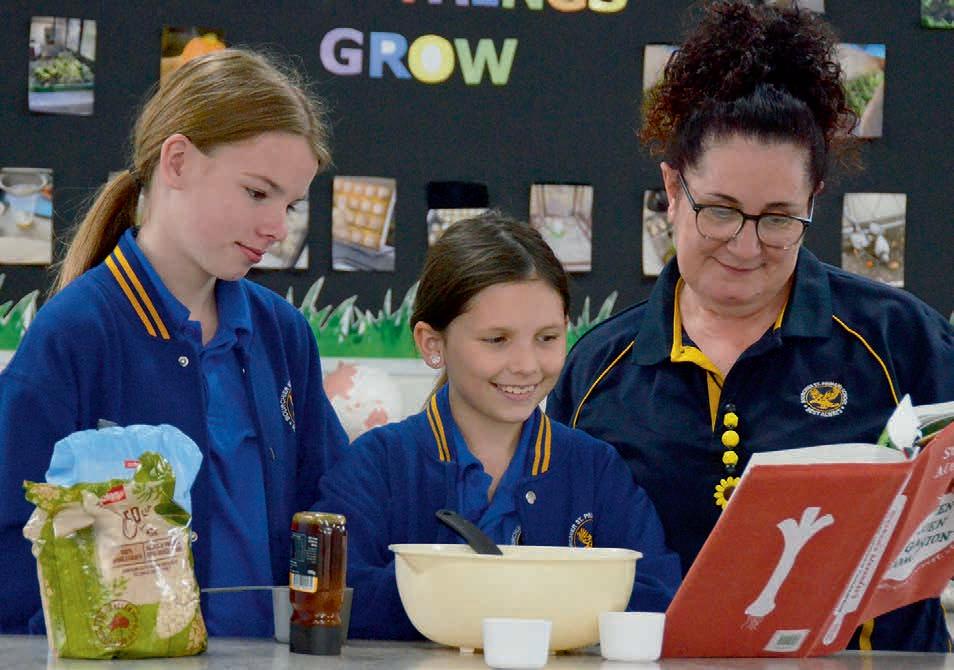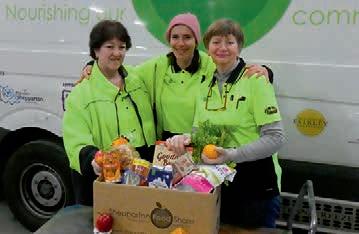GREENER GREATER SHEPPARTON
A greener path for a greater tomorrow.
A greener path for a greater tomorrow.












By adopting small yet impactful habits, such as reducing single-use plastic, conserving energy, planting trees, supporting eco-friendly products, and bringing your own coffee cup to your favourite café (just to name a few), you can help make positive changes towards a sustainable future.
Within these pages, you’ll find articles on climate change, community initiatives that are driving change, and insights from Greater Shepparton City Council’s chief executive officer Peter Harriott.


Editor: Kylie Pogue
Writers: Kelly Carmody
Design: McPherson Media Group
There are opportunities to learn, to be reminded, and hopefully, to be inspired.
If you can take just one thing from this magazine, then you’re on your way to becoming a part of a change that will help contribute to a greener, greater Shepparton, and a better world.

Join us on this journey of transformation as we pave the way for a greener tomorrow, empowering individuals to create a greater world through sustainable actions.

 - Kelly Carmody
- Kelly Carmody
Advertising: Simone Dunne 5820 3134
Leesa Haeusler 5820 3188
Carolyn Harrington 5820 3187
Leah Doyle 5820 3159
Published by Shepparton News, PO Box 204, Shepparton VIC 3632, (03) 5831 2312

2 A GREENER GREATER SHEPPARTON






























ESCAPE SOARING ENERGY COSTS WITH SOLAR Byers – a friendly family, locally owned business with an unbeatable reputation for quality and efficiency ELECTRICAL SOLAR DATA HEATING & COOLING CCTV 90825 Tired of escalating residential, commercial, or industrial power bills? It’s time to consider solar solutions. Contact our solar specialists for a tailored quote. 03 5831 1890 BYERS ELECTRICAL (VIC) PTY LTD ABN: 88 120 082 180 | REC: 15896 | NSW CERT: 571975 47-49 Benalla Road, Shepparton | www.byerselectrical.com.au
2030 vision: Zero carbon emissions target
In March 2020, Greater Shepparton City Council took a significant step towards addressing the global climate crisis by declaring a Climate Emergency.
This move aligned the council with a growing international movement, joining 1855 government jurisdictions across 33 countries, including 97 councils in Australia, that have recognised the urgent need to combat climate change.
As part of their commitment to this cause, the council set forth a bold target to achieve a Zero Carbon Emissions status by 2030, focusing on reducing carbon emissions originating from human activities, such as the burning of fossil fuels for electricity, heating and transportation.
The primary objective of this target is to eliminate council’s operational carbon emissions entirely within the next decade.
Guided by the core principle of leaving places in a better state than found, Greater Shepparton City Council chief executive officer Peter Harriott said to ensure the successful implementation of their climate ambitions, the council developed a comprehensive Climate Emergency Action Plan.


“This plan, titled Our Climate Safe Future, reflects a collaborative approach involving active partnerships between the community and the council,” Mr Harriott said.
“The action plan encompasses 80 initiatives strategically categorised into four key priorities: climate change leadership, transitioning to net zero emissions, building a climate-resilient community and supporting a thriving and climate-ready agricultural sector.
“Through this action-oriented approach, Greater Shepparton City Council aims to lead by example, inspiring other local authorities and organisations to follow suit in addressing the pressing climate crisis.
“By forging a path towards a sustainable and environmentally responsible future, we hope to create a positive impact, not only for our own community but also for the broader global effort to combat climate change.”
For those interested in learning more about the Climate Emergency movement and exploring other organisations that have declared a climate emergency, the Climate Emergency Declaration and Mobilisation in Action website serves as a valuable resource, visit: www.cedamia.org/
“Ask yourself how you can help, because you can make a difference. Time is not on our side, and the urgency to act has never been greater,” Mr Harriott said.
“As a household, an individual, or a business, you have the power to take meaningful steps towards securing a safer and more sustainable planet for future generations.
“By working hand in hand, together we can create transformative change. Every action, no matter how small, counts.”
Greater Shepparton City Council is dedicated to leading by example, and they invite you to join them on this critical journey.
“Together, we can build a thriving and resilient future for ourselves and for the generations yet to come.”
For more information on the Greater Shepparton City Council’s Climate Energy Declaration; Climate Emergency Action Plan; 2030 Zero Emissions Target, and the Shepparton Statement, visit greatershepparton.com.au/ animals-environment-and-waste/environment/climateemergency
4 A GREENER GREATER SHEPPARTON
Greater Shepparton City Council chief executive officer Peter Harriott
Greening Greater Shepparton begins with the ‘whys and hows’
Education is the starting point for the Greening of Greater Shepparton.
That sounds somewhat trite, but before anyone embarks on any sort of journey or project, they want to know the reasons for what they are doing and the likely rewards, both personally and for the wider community.
And so the ‘Greening of Greater Shepparton’ is in that category — what should I do and why should I do this?
Well, let’s tackle the second question first — why should I do this?
The Greater Shepparton climate is warming, with temperatures well in excess of 40ºC not uncommon, with 45ºC and more clearly on the horizon, and ultimately successive days of 50ºC.
And even though they are what are called dry bulb temperatures, working outside on 50ºC days is well nigh on impossible.
With wet bulb temperatures — that’s when the humidity is also measured — things become doubly difficult because when the temperatures climb into the high 30s on a high humidity day. Even a fit young person with an unlimited
supply of water, but without shelter, will survive, when outdoors, for less than an hour.
Here is where the greening comes in, and so we now consider the first question — what should I do?
In short, plant trees, shrubs and grass.
Mostly, however, it should be trees, as many as you can plant.
As trees mature they absorb carbon dioxide and while providing that remarkable service they are also protecting us from the ever-increasing heat through the cover and shade they bestow.
Temperatures in the shade of a tree are measurably lower, often several degrees, and that, combined with grass, can literally be a life saver.
Beyond the shade they provide, trees, when combined with shrubs, provide a wind break and, further, a refuge for birds and other tiny critters that also need somewhere to live.
Therein lies a ‘tool’ for farmers, as a properly laid out array of trees and shrubs will create shade, a windbreak for their animals and, if linked together across the property, will become nature’s corridors. So, those corridors become hotspots for biodiversity.
Shepparton’s urban areas are heat-traps in that they are largely paved with either bitumen or cement, two things that worsen the intensity of hot weather.
The idea that the Greening of Greater Shepparton begins with education is a dangerous one, as after decades of individualism being instilled in people, they can become quite reactionary to the idea of being schooled to be as one with their communities. The dust cover on the new book History of Climate Change, by the director of the Institute of Geosciences and Earth Resources at the National Research Council of Italy, Antonello Provenzale, says we need to understand how the climate works and how human activity is affecting it.
“Not in order to save the planet,” it says, “which will do just fine on it’s own … but to save ourselves.”
The Greening of Greater Shepparton is about that understanding of how the climate works and taking steps “to save ourselves”.
- Robert Mclean
5 A GREENER GREATER SHEPPARTON
Tree group nursery blossoms
In the early ’80s a small group of enthusiastic gardeners came together with a shared passion, to form a nursery that traditionally grew trees.
Their aim was to help provide a range of environmental benefits for various customers, some of which where local farmers and still are to this day.
Fast forward almost 40 years, and now the Goulburn Valley Tree Group Nursery in Tatura is run by around 20 dedicated volunteers and has evolved into a knowledgeable hub that has produced more than 1,000,000 trees since its inception.

This group is more than just a nursery that sells an extensive range of native plants, they are a group of passionate people that are helping send a message that promotes biodiversity in the region.
“The more trees we get in the ground the better we are to the planet,” volunteer Deb Lynch said.
“And if you’re planting trees in the ground, you’re actually helping turn things around.”
The group provides a wide range of services that cover an extensive range of different planting techniques for farms and the backyard garden.
Whether it’s a wind block your property is needing with an under-story of plants that will create further barriers on your land, or you’re generally just unsure of how to make your home garden thrive, then this group is worth visiting.
“There are so many benefits to native gardens,” Deb said.
“They use less water and once established they practically look after themselves.
“Flowering plants all encourage birds, bees, insects, and butterflies which are all
important for pollination and the overall health of ecosystems.
“If you’re not sure what to do or what to plant, need help or advice then please come and visit us.”
The nursery is a part of Landcare Victoria Inc and the Goulburn Murray Landcare Network and are located at 4-6 Kerford St, Tatura. They are open every Tuesday and Saturday morning, other than in August and a few weeks in September when they are closed. They sell about 40,000 plants per annum, with some species including local eucalyptus and wattles as well as other native species that thrive in this area.
Everything is grown on site from seedlings and nurtured through different processes before sale. Deb said it was a labour-intensive process but so rewarding to see the plant growth.
“Some of the biggest trees like a red gum have some of the smallest seeds I have ever seen,” she said.
“It’s really so amazing to witness the transformation.
“From humble seeds to flourishing plants, a testament to the resilience and wonder of the natural world.”
6 A GREENER GREATER SHEPPARTON
Goulburn Valley Tree Group Nursery volunteer Deb Lynch.
Raise the bar and use soap

Bar soap offers a multitude of benefits that make it a superior choice in personal hygiene. Not only is it cost-effective and eco-friendly, but it also provides an aromatic and sustainable bathing experience.
With a wide range of scents available, bar soaps allow you to indulge in delightful aromas during your cleansing routine.

From refreshing citrus notes to soothing lavender, there’s a bar soap fragrance to suit every preference.
Moreover, many bar soaps are crafted using eco-friendly and sustainable practices. They are often made with natural ingredients, avoiding harsh chemicals and reducing environmental impact.
Additionally, their minimal packaging and recyclable wrappers contribute to a greener planet.
By opting for bar soap, you not only treat yourself to a sensory delight but also play a part in reducing plastic
waste and supporting environmentally conscious production methods.




Bar soap combines the benefits of affordability, sustainability, and a variety of pleasing scents.
Embrace the eco-friendly and fragrant world of bar soap, elevating your bathing experience while treading lightly on the planet.
IT’S ABOUT HOW WE ACT NOT IF WE ACT.

Earlier this year I hosted climate experts to meet with businesses and councils in our region.

This harvested strong support across industry to explore the viability of regional energy hubs and developing a circular economy.


87990 7 A GREENER GREATER SHEPPARTON
I’m determined to foster these relationships to ensure jobs, profitability and productivity grow in our region long into the future.
WHY NOT MAKE A WORM FARM?
Setting up a worm farm, also known as vermicomposting, is a great way to recycle organic waste and produce nutrient-rich compost for your garden.
Choose a suitable container: You’ll need a container to house your worms. It could be a wooden box, a plastic bin, or a specialised worm farm kit available in the market. Ensure that it has a lid and good ventilation.
Create bedding: Worms need a comfortable environment to thrive. Start by adding bedding material to the container. Shredded newspaper, cardboard, coconut coir, or a mixture of these materials work well. Moisten the bedding with water until it feels damp but not soggy.
Add worms: Red worms, also known as red wigglers or Eisenia fetida, are the most commonly used worms for vermicomposting. You can purchase them from a gardening store or online. Introduce the worms to the bedding, spreading them evenly across the surface.
Feed the worms: Worms consume organic waste, so you’ll need to provide them with a balanced diet. They eat fruit and vegetable scraps, coffee grounds, tea leaves, crushed eggshells, and small amounts of shredded paper. Avoid feeding them meat, dairy, oily foods or anything that can attract pests.
Maintain the worm farm: Regularly check the moisture level in the worm farm. The bedding should remain damp, but excess moisture should be avoided as it can cause anaerobic conditions. If the bedding feels too dry, mist it with water. If it’s too wet, add dry bedding material.
Harvest the compost: Over time, the worms will break down the organic waste and turn it
into nutrient-rich compost. As the compost matures, you can harvest it for use in your garden. There are different methods for harvesting, but a common approach is to create a pile on one side of the container and add fresh bedding and food on the other side. The worms will migrate to the new bedding, allowing you to collect the finished compost from the pile.
Use the compost: The finished vermicompost is an excellent soil amendment. It improves soil structure, provides essential nutrients, and enhances plant growth. Use it to enrich potting mixes, add it to garden beds, or create compost tea for liquid fertilisation.
Remember, maintaining the worm farm requires attention and regular care. Keep an eye on the temperature, moisture levels, and the overall health of the worms. With proper care, your worm farm will provide you with a continuous supply of nutrient-rich compost while helping reduce waste.
8 A GREENER GREATER SHEPPARTON
Solar



It’s the cheapest form of any power available and the right sized system will power your house for years to come.
A Watters solar plan allows you to pay for the solar system using your monthly electricity bill.

A 3 year plan that can be cheaper than your current power bill
Genuine zero interest payments – someone else’s money for nothing
Lock in dirt cheap energy rates while you are on the plan
Batteries
Batteries are now more affordable and you can put them on the Watters monthly payment plan
Batteries are getting cheaper and you can attach them to the above plan
Feed in tariffs will soon be worth nothing
Gov’ts advising of extended power outages in extreme weather (El-Nino is coming)
Power costs outside solar hours will get more expensive – a battery will protect you from high night rates

Heating needs to be electric Gas prices are going through the roof and gas and supply not even guaranteed down the track
Reverse cycle air conditioners placed in high traffic areas saves big $$$
Watters can install and integrate all of your renewable options:

Gas hot water and old off peak electric hot water systems
Hot water can represent 30% of your power bill
You need to disconnect these as soon as you are able. EXTREMELY inefficient Electric heat pumps use 75% less and when powered by solar its “free”


Gas stove tops
Move these on and replace with electric or induction cooktops
Electric Vehicles are coming!
Plan for this as it may be the next vehicle you purchase Be an early adopter, lead the charge!!
All of these devices can be interconnected and provide you with genuine control of how your house is performing and the money saved
Make sure you have enough solar now for all of the above Federal and State Government subsidies are available and we can help 65 years of doing the right thing by the community is our guarantee to you
Only quality products and ongoing warranty support – trust is worth a fortune!

Watters Electrical
www.watters.com.au 1300 928 837 The Power To Do More 89322
responsible solutions for a thriving environment
At Project Green, their core values revolve around the profound respect and appreciation for the life of trees.
They believe in giving the environment a voice and fostering a more environmentally responsible future for generations to come. Their commitment to these principles drives holistic solutions that nurture and protect our precious natural assets.
Project Green’s national business development manager Steven McKenney said that by utilising their innovative green asset mapping and management system (EDEN4), they delivered comprehensive solutions that address the diverse needs of both the client and the environment.
“With EDEN4, we can maximise the potential of green assets and ensure they thrive under our care,” Steven said.
“Now, you might be wondering what sets us apart from traditional approaches. It’s simple: instead of resorting to chopping down trees, we are passionately dedicated to their preservation and wellbeing.
“By keeping them alive and thriving, we not only preserve the beauty of our surroundings but also actively contribute to a healthier planet.”
For Project Green the life of a tree doesn’t end with removal. Rather it represents the beginning of its new life.
This is achieved through Project Green’s connection with the larger Project Green Group. As a PGG company, Project Green can provide a truly holistic end-to-end tree management solution.

For example, all suitable wood removed from a Project Green worksite finds its way to Wood for Good with the help from Austral Trees (both of which are PGG companies). The wood is then processed and repurposed with all profits going to charity.
“It’s our way of paying it forward and Wood for Good is doing great things in the community,” Steven said. “Wood is being recycled into bulk and bagged firewood, bagged kindling, sawdust and even garden mulch, and all the profits go to a charity chosen by our employees.
“Remember, the choices we make today impact the world we pass on to tomorrow. Together, we can nurture and protect our natural treasures for the wellbeing of all living beings.”
For more information on the Project Green Group, or any of its companies (EDEN4, Project Green, Austral Tree Service or Wood for Good), visit www.pgg.com.au Their team is committed to providing environmentally responsible solutions and invite others to join them in their journey towards a greener, more promising future.
10 A GREENER GREATER SHEPPARTON






CLEAN UP YOUR BUSINESS, SHED OR PROPERTY At Future Recycling it’s all about keeping it local and sustainable. That’s why we support local business and are certified Carbon Neutral. We also have the regions only 24hr public weighbridge Taking all metal, and anything made of metal. Copper, brass, cans, old ovens or fridges, old machinery, and batteries Bins can be supplied for those with large amounts of scrap Shepparton Depot, 121 Old Dookie Rd, Shepparton Phone: 03 5821 7876 Visit www.futurerecycling.com.au for more information Trading Hours: Monday to Friday 8.00am - 4.30pm Follow us on Facebook for info and offers /futurerecycling 92633
When it comes to food storage, have you ever considered using jars?
This simple practice can offer numerous benefits for all types of foods.
Firstly, storing food in jars helps to preserve its freshness and extend its shelf life.
Whether it’s cooked meals, leftovers, or raw ingredients, jars provide an airtight seal that keeps food protected from air and moisture, reducing the risk of spoilage.

The convenience of jar storage is another advantage. By portioning and storing foods in jars, you can have preprepared meals or snacks readily available. This saves time and effort, especially during busy days when you need quick and easy access to nourishing food. Additionally, storing foods in clear jars enhances visual appeal and organisation. You can create appealing displays of colourful ingredients, making it easier to identify and plan meals.
Storing food in jars a bonus Hand me downs, boots and all
Jars also help keep your pantry or refrigerator neat and tidy, preventing food items from getting lost or creating clutter. Portability is another perk of storing food in jars. They are portable and can be easily packed for picnics, work lunches, or travel.
From salads to soups, you can conveniently take a wide variety of foods on the go, ensuring you have healthy and delicious options wherever you are.
By storing foods in jars, you can reduce food waste by preventing spoilage and extending their freshness. This saves money and promotes sustainability by minimising discarded food.
Whether it’s fruits, vegetables, grains, or even complete meals, embracing jar storage can offer a range of benefits. Make the most of this versatile and practical food storage solution to enjoy the advantages of fresh, convenient, and organised food every day.
Tatura Football Netball Club is encouraging its junior players to pass their football boots down after they have grown out of them. Pictured is Fletcher Dunne with TFNC junior coordinator Michael Reid and Liam Beale.

The financial burden of purchasing new footy boots every season can be a financial barrier for many families to get through, especially as children’s feet seem to grow overnight, but in the world of Australian football clubs, a new tradition is making a significant impact — the practice of handing them down.
Many junior league teams around the country including the Tatura Football Netball Club are embracing the ‘pre-owned boots initiative’ calling it a clever way to contribute to
sustainability and think about things in a different way.
TFNC junior coordinator Michael Reid said their club has welcomed the sharing of pre-owned boots and their junior kids have welcomed it to.
“By embracing this initiative, it ensures that aspiring young athletes have access to suitable footwear without straining their parents’ wallets.” Michael said.
“Rather than throwing them out, we encourage parents to bring them along to training at the start of the season, from there they are handed down to another junior player — we will be encouraging it at the start of every season.
“If there is nothing wrong with them, why not give them away?”
12 A GREENER GREATER SHEPPARTON
Unleash Savings on Your Energy Costs with Solar Power!


RESIDENTIAL & COMMERCIAL SOLAR SYSTEMS


INSTALLATION & BATTERY STORAGE SOLUTIONS
At Blake Campbell Solar, we’re committed to helping Shepparton homeowners save on their power bills by switching to solar.
And with our 6.6kW, 10.3kW & 13.32kW Premium Packages currently on sale, there’s never been a better time to make the switch.
With a range of different solar packages available, our team of local solar experts are here to help design the panel, inverter and installation that best suits YOUR needs and budget.
We’re Shepparton’s most trusted solar team for a reason, check out our exclusive solar offers: Get a HUGE 6.64kW Solar System from as little as $26.77 per week
Professional installation by local Shepparton CEC accredited installer and retailer
Get The Confidence Of Our 25 Year Panel Performance Guarantee

PLUS: 10 Year workmanship guarantee on installation
PLUS: 10 Year inverter warranty
Local Shepparton Family Run Business
We’re famous for our 5 Star customer service and after sales care
Embrace the Sun:
A: 7 Barker Avenue, Shepparton, Vic, 3630 E: blake@blakecampbellsolar.com.au www.blakecampbellsolar.com.au BLAKECAMPBELLSOLAR M: 0413 323 947 BLAKE CAMPBELL 89851
Greater Shepparton Bin collection changes from
16 October 2023
Let’s improve our waste & recycling efforts together
Find out which bin by visiting shepp.city/whichbin
GREEN Weekly YELLOW Fortnightly RED Fortnightly






Visible change is here
With the intent to achieve the Victorian Government’s landfill diversion target of 80 per cent by 2030, the Greater Shepparton City Council’s changes to kerbside waste collection services have begun.
With stage one now completed in Kialla and Tatura and the next stages rolling out in October, Greater Shepparton City Council Resource Recovery Centre manager Liam Moller said the positive adaptation to changes were already visible.
“The community has shown commitment to recycling appropriately and we are excited to further enhance great outcomes,” Liam said.
“Residents are improving waste and recycling habits at home which shows that great changes can be made.

“We look forward to supporting the rest of the community through the next stage.”
While processes are put into place to better manage waste and recycling become a part of everyday
life, Liam also said that illegal dumping of larger items posed concerns for health and safety in the community and hoped people would do the right thing.
“It also places significant impacts on the environment,” Liam said.
“It’s important for the community to dispose of items at the Resources Recovery Centres, in particular for those items that do not belong in kerbside bins in order to retain a healthy community and environment.”
The kerbside transition plan is expected to provide multiple benefits to economic, environmental, and regulatory targets, and residents are being encouraged to take the time to direct the right things to the right bins.
“We can all make an effort to reduce landfill waste generation and work together to increase waste diversion,” he said.
“As a community we can make a big impact.”
For more information on kerbside changes phone 5832 9700 or email waste@shepparton.vic.gov.au
16 A GREENER GREATER SHEPPARTON
Greater Shepparton City Council Resource Recovery Centre manager Liam Moller.
SHAPING A SUSTAINABLE TOMORROW!
PGG (Project Green Group) provides a comprehensive end to end arboriculture service including consulting, data capture/management, risk assessment and tree care.

















Are you ready to join the eco-revolution? Project Green Group invites you to be a part of our mission to transform the world for a greener, cleaner future. With a passion for planet Earth, we're dedicated to making sustainability accessible to all.


our pgg companies

The EDEN4 software platform is used to map, measure and manage green assets. EDEN4 combines data collection/analytics, compliance monitoring, risk assessment and workflow management into a single software solution.

Our green asset experts will consult with you on the health, risk-level, species, maintenance and ongoing care of every tree.
Our skilled arborists can assist with any tree-related problem you might have and they will do it with care and respect, both for you and the natural environment.

Our BCorp initiative converts the wood from trees we fell into firewood, which we then sell and our profits go to charity.

Visit us today at www.projectgreengroup.com and become a part of the change! 80211
Drop C unts
The bathroom accounts for about 40 per cent of a house’s total consumption.

There are plenty of ways you can be water wise around the home and save water. Here are some ideas that have been provided from Goulburn Valley Water.
IN THE KITCHEN
• Wait until your dishwasher is fully loaded before you turn it on, and use the eco cycle — if you’re looking to buy a new one, make sure it’s a water efficient model.
• Don’t pre-rinse your dishes — for most dishwashers, plates, etc only need a good scrape.
• Wash your vegetables and rinse dishes in a plugged sink or basin — not under a running tap.
• Catch running water while waiting for it to warm up and use it on your garden.
IN THE BATHROOM
• Keep your showers to four minutes. Taking shorter showers is one of the best ways to help save water — use a timer or you can find four-minute song playlists online.
• Install a WELS 4-star rated water saving showerhead and WELS 4-star rated water efficient taps to save on water and energy costs.
• Turn off the tap while you brush your teeth or shave
• If you’re using the bath, only fill it up as much as needed, and check the plug doesn’t leak.
• Use the half flush button on your toilet when you can — water efficient toilets only use three litres with the half flush button, while older toilets use about 18 litres
• Check there aren’t any leaks in your toilet — you can find out how to do this at Smart Water Advice’s website.
• Use a bucket to collect water to use on the garden while you’re waiting for the water to heat up.
• Shave your legs before you get in the shower.
IN THE LAUNDRY
• Wait until your washing machine is fully loaded before you turn it on and use the eco setting if your machine has one.
• If you’re buying a new machine, make sure it’s at least 4.5 WELS star (water efficiency rating).
• Check your taps and fittings for drips or leaks — a tap that drips once per minute can waste up to 12,000 litres a year.
goods, snacks, or even liquids if they are designed to be leak-proof.
Organisation: Plastic containers can be used to organise various items around the house. You can use them to store small toys, craft supplies, office supplies, or even as a drawer organiser.
Planters: Clean plastic containers can be converted into planters for small indoor plants or seedlings. Just make sure to poke drainage holes in the bottom and provide proper watering to prevent waterlogging.
REDUCE WASTE TO PROMOTE SUSTAINABILITY
Reusing plastic containers can be a practical way to reduce waste and minimise the need for single-use packaging. Here are some creative ideas on how to reuse plastic containers:
Food storage: Plastic containers are great for storing leftovers or packing lunches. They can be used to store dry
DIY projects: Plastic containers can be used for various DIY projects. They can be transformed into piggy banks, bird feeders, or even small storage bins with a little creativity.
Travel containers: When travelling, plastic containers can be used to store toiletries, small accessories, or snacks. They are lightweight, durable, and can help keep your belongings organised.
Arts and crafts: Plastic containers can be used in art projects or crafts. They can serve as paint containers, brush holders, or mixing palettes. Children can also use them for fun activities like making home-made slime or sensory bins.

Remember to clean the plastic containers thoroughly before reusing them to ensure hygiene and food safety. Additionally, if the plastic containers become worn out or damaged, it’s important to recycle them appropriately to prevent further environmental impact.

Every day a large amount of water is used inside the home. For washing ourselves, our clothes, brushing our teeth, flushing toilets, or cooking.
EVERY PRECIOUS 18 A GREENER GREATER SHEPPARTON
EarthSmart Range readily biodegradable. non-hazardous, non-toxic, chlorine free, phosphate free.







Enzyme Wizard

Made from renewable ingredients, septic safe, biodegradable, non-toxic, safe to use around entire home.

Who Gives a Crap 100% Recycled 3ply toilet paper contains no inks, dyes or scents.

Ph: (03) 5831 7228 28–36 New Dookie Rd Shepparton VIC 3630 (Near sale yards) www.everydaysupplies.com.au • Free Delivery throughout the GV OPEN TO PUBLIC LOOKING AFTER YOUR HOME AND THE ENVIRONMENT 87761 Check out our Eco Friendly products for everyday use. Safe for home, safe for nature.
and
and grey water friendly.
Earthon Laundry Powder Biodegradable
phosphate-free
Clothes recycling saves planet
Fast fashion is cheap, disposable clothing that is produced rapidly by mass-market retailers to keep up with the latest trends. Put quite simply, the industry is designed to encourage customers to shop more often, which in turn means people are buying more than they really need.
But if people are buying more than they need and then disposing of clothing just as fast, it’s no wonder clothing waste has become one of the largest contributors to Australia’s waste problem.
The fashion industry is one of the highest polluting industries in the world, and responsible for an estimated 10 per cent of global CO2 emissions.
Staggering statistics show that in landfill, decomposing materials can take up to hundreds of years to break down, so it’s no wonder passionate owner of The GV Wardrobe, Sam Sphinks, is setting out to send a message to our region about being kinder to our planet.
“While these clothes decompose, they are releasing methane and micro-plastics into the soil and eventually into our water streams,” Sam said.
“We need to make changes on how we shop to become kinder to the planet, and recycling clothing can make a big difference.”
What started as a thought in Sam’s mind through the global pandemic in a vacant bedroom in her home, is now a full-time, online, ladies and men’s wardrobe.
A place where quality clothing can be recycled and purchased at a flat rate of just $10 per item, and yes, the shop outgrew the bedroom and now has its very own space in Shepparton that’s helping create a solution to the clothing waste problem.

“It’s as if everybody’s wardrobe has been brought together in the one place,” Sam said.
“The concept is being embraced and making people aware that we all can shop differently, save money, and help create a more circular economy.”
Buy. Contribute. Repeat — that’s the concept. Browse the beautiful online store and purchase your items.
They will arrive in your mailbox lovingly and sustainably packaged, ready for you to wear and love, and when you are done with an item whether it is a day, month or year later, you can contribute it back to the wardrobe and they will give you a $2 coupon for each item as a thank you.
Then you repeat the cycle. You can spend your coupon, continue to contribute and to buy great condition items, and to be a part of The GV Wardrobe community.
“At the same time, it brings together a community who want to enjoy fashion while lessening the impact on the planet,” Sam said.
“It’s changing the way people shop.”
To become a part of this clever initiative all you have to do is visit www.thegvwardrobe.com and start shopping. Also look out for when the shop opens its doors to the public on occasions, because you can browse and try on what may become your next favourite outfit.
20 A GREENER GREATER SHEPPARTON
The GV Wardrobe owner Sam Sphinks is on a mission to encourage people to be kinder to our planet.
Metal recycling trailblazers

Most people don’t think about metal scrap yards when they think about environmental advances, I certainly didn’t.
Keen to see what was changing in the industry, I visited Daniel Thewma at the Future Recycling plant in Shepparton and was pleasantly surprised.
Shepparton, thanks to Daniel and his team, is not only keeping up with industry environmental standards, we are blazing a trail for others to follow.
Future Recycling is certified Carbon Neutral by Climate Active, whose certification process is one of the world’s most rigorous.

The team achieves this impressive standard through a number of measures, including fuel saving initiatives, renewable power and also through the purchase of carbon offsets.

This standard is not a matter of box ticking, it has involved major changes to the way business is done and evidence of these measures is made public through disclosure statements on the Climate Active website.
Perhaps more impressive about their environmental achievements is the fact the process is being kept local. The Future Recycling team is a team working to give Shepparton and the surrounding region the best possible service in any way possible, including providing the region’s only 24-hour public weighbridge.

Such is their commitment to ‘keeping it local’ they are the only regional metal recycler processing all the metal onsite before it is sent to smelter. All the sorting and shredding is done in Shepparton, not offloaded to a third party in Melbourne or interstate.
Whether you live on a farm or have a backyard, if you have any metal to clear off your property and you’re concerned about the environment or your community, it’s worth giving
ELECTRIC VEHICLE CHARGING
requirements, vehicle brand and customer To locate







charging stations, visit plugshare.com
ALL VEHICLE TYPES DETAILS
• Fraser St Carpark, Shepparton Evie Network: 50kW DC; CCS and CHAdeMO plugs; charges apply
• McLennan St Median Strip, Mooroopna Evie Network: 50kW DC; CCS and CHAdeMO plugs; charges apply
• Shepparton Art Museum, Shepparton 11kW AC (Type 2); Free







• Hogan St, Tatura (TatWash) ChargeFox Network: 25kW DC; CCS and CHAdeMO plugs; charges apply


RESTRICTED USAGE





• Tesla - Ashenden St Carpark Tesla 250 kW DC - Supercharger
• Tesla – Tallis Winery Destination charging for winery customers
• Museum of Vehicle Evolution (MOVE) MOVE visitors only; 22kW AC (Type 2)
Future Recycling team members Kirsty Argentino, Ebony Wilson, Daniel Thewma, James Legge and Chris Argentino are passionate about recycling to help the environment.
STATIONS
GOULBURN GOULBURN RIVER RIVER MURCHISON UNDERA MERRIGUM TOOLAMBA DHURRINGILE GILLESTON ARDMONA MOOROOPNA NORTH TOOLAMBA WEST MURCHISON EAST TATURA EAST BUNBARTHA MOOROOPNA NORTH WEST A39 C345 C357 C357 C369 C356 C351 C357 C358 GOULBURN GOULBURN RIVER RIVER MOOROOPNA TATURA MURCHISON UNDERA MERRIGUM TOOLAMBA DHURRINGILE BYRNESDALE GILLESTON MOOROOPNA NORTH TOOLAMBA WEST MURCHISON EAST BUNBARTHA MOOROOPNA NORTH WEST A39 C345 C357 C357 C369 C356 C355 C351 C357 Murchison to Rushworth Rail Trail TAMLEUGH WEST SHEPPARTON NORTH ZEERUST C366 DISTANCES BETWEEN TOWNS (kms) Shepparton Tatura Mooroopna Murchison Dookie Bendigo Albury Melbourne 20 5 36 30 120 173 188 20 15 20 49 107 192 180 5 15 30 33 117 177 193 36 20 30 67 95 187 160 30 49 33 67 150 153 223 120 107 117 95 150 282 152 173 192 177 187 153 282 323 188 180 193 160 223 152 323 Shepparton Tatura Mooroopna Murchison Dookie Bendigo Albury Melbourne N 0 10 km TAMLEUGH WEST SHEPPARTON NORTH C366 C358 N MOOROOPNA TATURA
Get smarter at home
Reporter Kelly Carmody sat down with Watters Electrical business development manager Reg Hickey to shed some light on the benefits of adopting a smarter, greener lifestyle.

As the cost of living continues to rise, and the need for environmentally friendly energy solutions becomes ever more apparent, smart living offers a compelling path forward.
Watters Electrical business development manager Reg Hickey has expertise in renewable and home energy management and offers valuable insights into how families can take control of their costs while reducing their carbon footprint.
Reg answered the following important energy saving and smart living questions to help make your home an ecofriendly haven.
What are some of the challenges faced by Australian families in terms of rising cost-of-living pressures?
The comfortable style of living in Australia is under threat, with increasing cost-of-living pressures affecting families significantly. One of the key touchpoints is the rising cost and limited availability of energy, particularly with the transformation of gas. Gas has become expensive and future supply is not guaranteed.
Why is transitioning away from gas and coal essential for a sustainable future?
Gas and coal have been traditional sources of energy for Australia for generations. However, their environmental impact is no longer acceptable for the planet. Governments are now taking charge of the transition towards renewable energy sources to create a sustainable future. Electrifying our living through the use of renewable power is now mandatory. State and Federal Governments are committed to assist homeowners and rentals complete the transition.
How can households take control of their energy costs and adopt a smarter way of living?
Solar energy is the first step in taking control of your cost of living and transitioning to a smarter lifestyle. By installing solar panels and batteries, homeowners become their own power company and create your own destiny. Smart devices connected to the home internet allow users to manage energy consumption effectively. Solar and a battery can remove 100 per cent of your electricity bill.
Can you explain how smart devices and timers play a role in managing power consumption at home?
Smart devices like washing machines, dishwashers, and hot water systems can be connected via home internet. Users can control when these devices work to maximise the use of your free solar power. For example, setting timers on the dishwasher and washing machine to run during peak solar production hours reduces reliance on grid power. This type of living reduces high consumption periods when we get home from work and school and turn everything on.
How can heat pumps for hot water help homeowners save on their energy bills?
Hot water can represent a significant portion of energy consumption, up to 25 per cent. Replacing traditional hot water systems with heat pumps, which can be subsidised by the government, eliminates this component from the energy bill. Using solar for the house and heat pumps for hot water, you have just smashed your power bill.
22 A GREENER GREATER SHEPPARTON
How do solar and battery systems empower homeowners to manage their energy consumption better?
Solar and battery systems provide apps for your phone to track power production, while smart meters offer information on consumption. By understanding this data, homeowners can effectively manage when and how they use their power, reducing reliance on the grid and saving money.
What are some of the additional benefits of embracing smart living and home energy management?
Smart living not only helps you save money but also contributes to protecting the environment. Additionally, with the rise of electric vehicles, homeowners can now charge their cars at home and even use the large batteries in the cars as a power source for their homes.
How affordable is it to own a solar and battery system?
The way you can own solar and a battery is changing. At Watters, we offer our customers a genuine interest free payment plan that is paid through your electricity rates. It’s a real game changer as we help our customers lock
in cheap electricity rates for a three or five-year period. We help our customers change the relationship with the electricity retailer. Why be reliant on them and their increased rates when you can do it yourself?
How can the energy services team at Watters assist homeowners on their journey to automate their homes?

We can guide homeowners step-by-step through the process of making their homes smarter and more energy efficient. By explaining the small steps required and demonstrating the potential savings, homeowners can embark on an exciting journey towards a greener lifestyle.
What is the future outlook for smart living in Australia?
With the building blocks now in place, the future of smart living in Australia looks promising. Electric vehicles, solar energy, and battery systems have opened up new possibilities for homeowners to save money, protect the environment, and feel empowered in their energy choices. A smarter, greener lifestyle is now easily accessible and manageable with the right support.
23 A GREENER GREATER SHEPPARTON
Watters Electrical business development manager Reg Hickey guiding homeowners Mark and Kali Frost through the step-by-step process of making their homes smarter and more energy efficient.
From little things big things grow
Inspired by Stephanie Alexander Kitchen Garden Foundation, Bourchier St Primary School in Shepparton has adapted its own unique teaching methods to its middle school students in a program called The Kitchen Garden.


The engaging program that has now been running in the school for 11 years has proved to be a wonderful opportunity for students to learn all about sustainability in a cycle, while teaching them how fruit and vegies and even eggs can get from the garden and chook shed, right to their plate.
The school’s Year 4 learning specialist teacher Jon Treanor, and kitchen garden teacher Angela Gagliardi, said everyday was a new day for kids to be inspired, learn, and try things they might never have had the opportunity to do before.
“The program is much more than just harvesting vegetables,” Jon said.
“The students learn about maintaining plants, caring for animals, eco systems and then how fruit and vegetables from the garden can be cooked in a variety of ways in Ange’s kitchen.
“They even learn about how food scraps become chook food — it’s a cycle that opens their eyes and they love it.”
In Ange’s kitchen there are some simple rules. Hair up, sanitise hands and every student must ‘try’ the cooked meals or snacks that they have prepared together as a class, at least three times, before they are allowed to say, ‘they don’t like it’.
“Everyone has to have a go,” Angela said.
“The program also encourages healthy eating and sometimes children don’t know what’s good for them or if they will like it until they have tried it — so I cook different things in
different ways and most of the children really have a go.
“It’s amazing to see how much they thrive and learn; I love inspiring them.”
Bouchier St Primary School has around 650 students from all different cultures, and recipes are often supplied by students’ parents and then celebrated in the school’s kitchen cook ups.
Another unique and inspiring aspect of bringing engaged learning to the forefront of their students’ minds.
Watching a seed grow into a plant and the processes in between are as important as watching a child grow into an adult, and if every school is passionate about both, then the hope for a brighter more sustainable future is possible — because from little things big things grow.
Bourchier St Primary School Year 4 students Beau Cassidy, Joseph Faamoe and Mehmet Ulu harvesting vegies in their school vegetable patch.
24 A GREENER GREATER SHEPPARTON
Bourchier St Primary School Year 4 students Maci Baldi and Leilani Beckett getting ready to cook up a storm with kitchen garden teacher Angela Gagliardi.
FREEZE FOOD FOR FRESHNESS
Preserving food through freezing before its expiry date offers several benefits.












Extended shelf life: Freezing food effectively slows down the natural spoilage process, allowing you to extend the shelf life of perishable items. By freezing food before it expires, you can retain its quality and freshness for an extended period.
Minimising food waste: Freezing food before it expires helps reduce food waste. Instead of discarding food that you won't consume before the expiration date, you can












freeze it to preserve its nutritional value and taste for future use.





Cost savings: By freezing food before it expires, you can take advantage of sales, discounts, or bulk purchases without worrying about immediate consumption. It enables you to stock up on perishable items when they are more affordable, saving money in the long run.
Convenience and meal planning: Freezing food before it expires provides convenience and flexibility in meal planning. You can prepare meals in advance and freeze them, creating ready-to-eat or easy-to-prepare options for busy days. It allows you to have a variety of meals readily available, reducing the need for last-minute take-out or unhealthy food choices.
Nutritional value retention: Freezing food can help retain its nutritional value. Many nutrients are relatively stable when frozen, ensuring that you still benefit from essential vitamins, minerals, and other nutrients when you consume the frozen food later.

Preservation of seasonal foods: Freezing food before it expires allows you to preserve seasonal produce or ingredients. You can enjoy fruits, vegetables, or other seasonal items throughout the year, even when they are not in season.
Remember to follow proper freezing techniques, use appropriate storage containers or packaging, and label items with dates to maintain food safety and optimise the benefits of freezing.
90767 THANK YOU your support helps keep our doors open! www.sheppartonfoodshare.org.au SCAN to donate Every $1 donated = 3 meals Your donation SUPPORTS LOCAL PEOPLE IN NEED The equivalent of 7.8 million meals distributed since 2012 Around 300,000 kilos of edible food saved from waste annually On average 7,500 kilos of food rescued monthly Local people contribute up to 150 volunteer hours weekly 139 agencies, schools & churches registered to collect Foodshare food. Half collect regularly, distributing around 30,000 kilos of food to the people they support monthly
Our world is
Notre Dame College Community
From the Thanks.
To the passionate and inspiring members of the student-led sustainability group Terra Tomodachi,
better
because you’re in it.
SO MANY REASONS TO GROW YOUR OWN
Having your own vegie garden contributes significantly to sustainability and a greener future in several ways:
Reduced food miles: Growing your vegetables at home eliminates the need for transportation, reducing greenhouse gas emissions associated with food miles and contributing to lower carbon footprints.
Water conservation: Personal gardens can be more water-efficient than large-scale agricultural practices, promoting responsible water use and conservation.
Biodiversity support: Home gardens often encourage diverse plant varieties, attracting beneficial insects, birds, and pollinators, which fosters biodiversity and helps maintain ecological balance.
Organic practices: By controlling what goes into your garden, you can prioritise organic and eco-friendly gardening methods, avoiding harmful pesticides and synthetic fertilisers.
Composting and waste reduction: Vegetable scraps and garden waste can be composted, reducing household waste and providing nutrient-rich compost for the garden.
Preservation of open spaces: Encouraging urban gardening and rooftop gardens can help preserve open
spaces, preventing further urban sprawl and preserving natural habitats.
Educational opportunities: Vegetable gardens at home offer valuable learning experiences for individuals and families, fostering environmental awareness and sustainable practices.
Resilience and food security: Growing your vegetables provides a degree of self-sufficiency and food security, especially during times of supply chain disruptions or food shortages.
Community building: Home gardening often leads to the formation of community gardens, fostering a sense of camaraderie and collaboration among neighbours with shared sustainability goals.
Inspiring others: Visible home gardens can serve as a model for others in the community, inspiring them to start their gardens and adopt more sustainable lifestyles.
Overall, having a vegie garden at home is a tangible way to participate in sustainable living, support environmental health, and contribute to a greener, greater future for all.
26 A GREENER GREATER SHEPPARTON
EMPOWERING ECO -SAVINGS
There are many inspirational ways to cut household energy bills and protect the environment.
In today's world, finding ways to save money on household energy bills while also being environmentally conscious has become increasingly important.
Fortunately, there are several inspirational strategies that can help you achieve both financial and environmental goals.
One of the most effective ways to reduce energy consumption and lower your bills is by embracing energyefficient appliances.
Look for appliances with the Energy Star label, which signifies that they meet strict energy efficiency standards. By investing in these appliances, you can significantly reduce your electricity usage and save money in the long run.
Another simple yet impactful step is to unplug electronic devices and switch them off when not in use.
Many devices continue to draw power even when they're not actively being used, contributing to “vampire energy” consumption. By making a habit of unplugging chargers, turning off lights, and powering down electronics completely, you can eliminate this wasteful energy usage and see noticeable savings on your bills.
Harnessing natural light is not only a great way to create a pleasant ambiance in your home but also to reduce your reliance on artificial lighting.
During daylight hours, open curtains and blinds to let natural light fill your space. This small change can lead to significant energy savings over time.
Consider upgrading your lighting fixtures to energyefficient LED bulbs. LED lights use significantly less energy than traditional incandescent bulbs and have a much longer lifespan.
Although the upfront cost may be slightly higher, the longterm savings and reduced environmental impact make it a worthwhile investment.
To optimise your heating and cooling systems, focus on improving the insulation of your home. Properly sealing gaps and cracks, insulating your attic, and installing energyefficient windows can prevent heat loss during winter and minimise heat gain during summer.
Additionally, using programmable or smart thermostats allows you to regulate temperature settings more efficiently, further reducing energy waste.
Exploring renewable energy options is another fantastic way to save money on energy bills while supporting the environment.
Installing solar panels or utilising other renewable energy sources can generate clean, sustainable power for your home, reducing your reliance on fossil fuels and lowering your energy costs.
Lastly, adopting water conservation practices can indirectly save energy. Fixing leaky facets, taking shorter showers, and using water-saving appliances can reduce both water and energy waste.
By implementing these inspirational energy-saving strategies, you can make a positive impact on both your finances and the environment.
Embrace energy efficiency, make conscious choices, and take small steps toward a greener lifestyle.
Remember, every effort counts, and together we can create a more sustainable future for generations to come.
27 A GREENER GREATER SHEPPARTON















 - Kelly Carmody
- Kelly Carmody





















































































































































